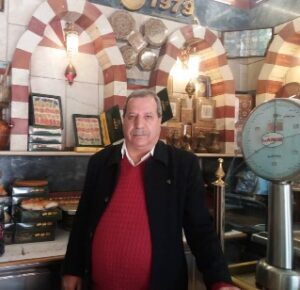Pistachio Mabroma, Baklava, Baloria and Aseya are among the distinguished Damascene sweets, whose industry dates back to pre-Ottoman period, and they flourish in the Syrian Capital (Damascus) relying on inherited experiences in this field.
These types of sweets or desserts have reached all Arab, European and American countries as they have been taken as gifts by foreign tourists or Syrian expatriates to their friends and relatives.
Mr. Suleiman Dawod, who has an old shop in Al-Midan district in Damascus told Syria Times: “In the past, people in Syria were making sweets only during religious occasions at their houses, and then several shops opened in Damascus to sell sweets…The number of sweet shops increased in 1960s as the Damascene sweets have been known for being distinguishable and the best all over the world.. Our sweets were a leading export as well as a must-have souvenir for visiting tourists.”
He clarified that the secret of the distinguished taste of the Damascene sweets lies in professionalism in production and the unique characteristics of the Syrian pistachio which is used in making sweets.
 He indicated that the number of sweets shops increased in Al-Midan district because this area is located on the main road for passengers towards Jordan or Gulf states. So all passengers could buy boxes of sweets before leaving Syria.
He indicated that the number of sweets shops increased in Al-Midan district because this area is located on the main road for passengers towards Jordan or Gulf states. So all passengers could buy boxes of sweets before leaving Syria. Moreover, he referred to the fact that the shops have developed the way of packing the sweets and the model of boxes to meet the needs of customers all over the world.
Since the sixties of the last century until now, the Damascene sweets industry has witnessed a great development in terms of the number of types, according to Mr. Dawod.
“There are more than ten types of Baklava – for instance Kol wa shkor (Eat and Thank) is different from the Baklava in shape and taste (because the process of condensing the pistachio inside it is done with ghee and not with sugar) . Aseya which is smaller is also different from Baklava with a higher percentage of pistachios inside it and other types are added,” he said.
For a long time ago, Baklava was stuffed with pistachios only, but now it is stuffed with cashews, hazelnuts, almonds, and other nuts. It can also contain one or more layers of Knafeh..
Mr. Dawod added: “Also the Mabroma industry which is very popular because of its low-fat content has developed through making new types such as Esh Al-Bolbul..In addition, Maamoul is no longer stuffed with dates and pistachios only, but we have covered it with sesame and added fruits to it, such as bitter orange, orange, strawberries and apples.”
The enticing smell that wafts from sweet shops attracts passersby in the district of Al-Midan.
The price of a kilo of luxury sweets nowadays ranges between 94,000 Syrian
Pounds and 126.000 Syrian Pounds ($13-$18)
Reported by: Basma Qaddour

